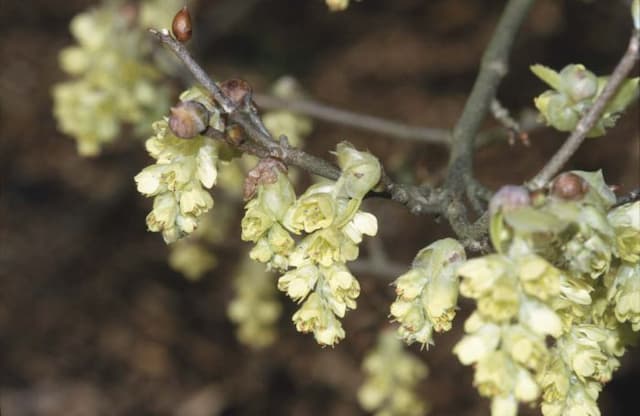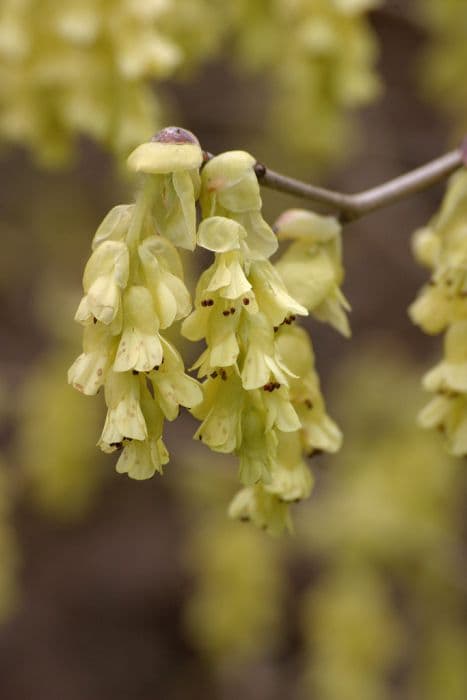Witch Hazel Hamamelis × intermedia 'Robert'

ABOUT
The plant commonly known as 'Robert' is a hybrid type that showcases a presence in the garden with its unique features. Characterized by its vibrant flowers, the plant bears a striking resemblance to ribbons with a twist, presenting in a warm palette that shifts from yellow to copper-red. These blossoms create a display of color during the colder months when most other plants have ceased to bloom, often emerging in the latter part of winter or the onset of spring. The leaves of 'Robert' have an attractive quality as well, typically gaining attention with their broad and rounded shape. These leaves are known for their ability to change with the seasons. In the warmer months, they convey a lush green hue, which then transitions to an array of colors, from yellow to orange and red, as the cooler temperatures of autumn set in. This plant is adorned with a framework that is both rounded and somewhat vase-shaped, giving it an open, airy structure. The branches reach out and arch gracefully, providing an elegant silhouette even when the plant is not in bloom. The bark has a smooth texture and is visually interesting, sometimes exfoliating to reveal different colors underneath, which adds another level of intrigue to its appearance. In addition to its beauty, the plant is noted for its pleasing fragrance. When in bloom, the flowers emit a subtle and delightful perfume that can be detected from a distance, inviting visitors to come closer and enjoy the sensory experience it provides. As the seasons change, 'Robert' continues to evolve in its appearance, ensuring that it remains a point of interest in the garden throughout the year with its dynamic changes and resilient beauty.
About this plant
 Names
NamesFamily
Hamamelidaceae
Synonyms
Witch Hazel, Hybrid Witch Hazel
Common names
Hamamelis × intermedia 'Robert'
 Toxicity
ToxicityTo humans
Witch hazel generally is not considered toxic to humans. However, as with any plant, individual reactions can vary, and it might cause mild stomach upset if ingested in large quantities. There are no well-documented cases of poisoning from ingesting witch hazel.
To pets
Witch hazel is not commonly known to be toxic to pets. However, ingestion of large amounts of plant material may lead to gastrointestinal upset, such as vomiting or diarrhea, in some animals. It is always advisable to prevent pets from consuming plants not meant for their consumption.
 Characteristics
CharacteristicsLife cycle
Perennials
Foliage type
Deciduous
Color of leaves
Green
Flower color
Yellow
Height
10-15 feet (3-4.5 meters)
Spread
10-15 feet (3-4.5 meters)
Plant type
Shrub
Hardiness zones
5-8
Native area
Hybrid
Benefits
 General Benefits
General Benefits- Ornamental Value: Adds visual appeal to gardens with its vibrant yellow to orange-red flowers that bloom in late winter to early spring.
- Wildlife Attraction: Attracts birds and beneficial insects, providing habitat and food sources in the garden ecosystem.
- Low Maintenance: Once established, it requires minimal care, making it suitable for gardeners of all skill levels.
- Year-Round Interest: Offers a range of seasonal features, from flowers in winter to lush green foliage in summer and colorful leaves in autumn.
- Drought Tolerance: Can withstand periods of dryness once mature, reducing the need for frequent watering.
- Cold Hardy: Adaptable to cold climates and can survive harsh winters, making it suitable for gardens in colder regions.
- Tolerates Different Soil Types: Can grow in a variety of soil conditions, from acidic to loamy, increasing its versatility in landscaping.
- Non-Invasive: Unlike some other plants, it does not aggressively spread, which makes it easier to manage in a garden setting.
 Medical Properties
Medical PropertiesThis plant is not used for medical purposes.
 Air-purifying Qualities
Air-purifying QualitiesThis plant is not specifically known for air purifying qualities.
 Other Uses
Other Uses- In crafting, Witch Hazel branches can be used in making wreaths or as an attractive addition to floral arrangements due to their twisted, sculptural shapes.
- Witch Hazel's strong branches are sometimes employed in the creation of natural walking sticks or in rustic furniture making.
- The plant can act as a natural barrier or hedge when planted in a row due to its dense foliage and large spread.
- In photography and painting, Witch Hazel is often used as a subject for its picturesque blossoms and vibrant fall foliage.
- The fibers from the inner bark of Witch Hazel can be used in traditional textile crafts such as basket weaving.
- The plant's seed pods are used in some cultures for traditional decorative purposes, particularly in autumn-themed displays.
- Gardeners sometimes use Witch Hazel branches as natural stakes to support other plants in their gardens.
- During the fall, the colorful leaves of Witch Hazel can be collected and used in creating natural, biodegradable confetti for events.
- As an educational tool, Witch Hazel can be included in botanic gardens or school projects to teach about native plants and their ecological importance.
- The plant may be used in landscape design for erosion control, as its root system can help stabilize the soil on slopes.
Interesting Facts
 Feng Shui
Feng ShuiWitch hazel is not used in Feng Shui practice.
 Zodiac Sign Compitability
Zodiac Sign CompitabilityWitch hazel is not used in astrology practice.
 Plant Symbolism
Plant Symbolism- Early Bloom: Hamamelis × intermedia 'Robert', commonly known as the Witch Hazel, often blooms in late winter or early spring, symbolizing new beginnings and the hope that comes with the end of winter.
- Healing: Witch Hazel has been used for medicinal purposes for centuries. It symbolizes healing and is often associated with its ability to soothe skin irritations and inflammation.
- Protection: Traditionally, Witch Hazel was believed to ward off negative influences and to protect against evil spirits, symbolizing protection and safety.
- Adaptability: Able to bloom in the coldest season, Witch Hazel symbolizes resilience and adaptability to harsh conditions.
 Water
WaterWitch Hazel 'Robert' prefers to be kept consistently moist, but it does not like to sit in waterlogged soil. During the growing season, water the plant deeply once every week, supplying about 1 to 1.5 gallons of water for medium-sized shrubs. In hot or windy weather, you might need to water twice a week. The goal is to keep the soil moist to about 12 inches deep. In winter, reduce watering, but do not allow the soil to completely dry out.
 Light
LightWitch Hazel 'Robert' thrives in full sun to partial shade. For optimal growth and flowering, place the plant in a location where it can receive at least 4 to 6 hours of direct sunlight daily. However, in regions with very hot summers, afternoon shade can help to protect the plant from excessive heat stress.
 Temperature
TemperatureWitch Hazel 'Robert' is hardy and adaptable, withstanding temperatures down to about -10°F and up to around 120°F; however, it prefers a temperate climate range between 60°F and 75°F. It's crucial to ensure that the plant is mulched and provided with wind protection in the colder zones to minimize temperature fluctuation stress.
 Pruning
PruningWitch Hazel 'Robert' should be pruned to maintain shape and remove any dead or damaged branches, which encourages healthy growth and flowering. The best time to prune is in early spring before new growth starts. Typically, once a year is sufficient for pruning Witch Hazel.
 Cleaning
CleaningAs needed
 Soil
SoilWitch Hazel 'Robert' prefers well-draining, organically rich soil. Aim for a soil pH between 5.5 and 6.5. A blend of loam, peat, and perlite would be ideal to ensure proper drainage while retaining adequate moisture.
 Repotting
RepottingWitch Hazel 'Robert' generally does not need frequent repotting; it can be done every 3-5 years. They prefer to be slightly root-bound, so only repot when necessary.
 Humidity & Misting
Humidity & MistingWitch Hazel 'Robert' is tolerant of a wide range of humidity levels but thrives best in moderate to high humidity. Avoid extremely dry air to maintain its vibrant foliage.
 Suitable locations
Suitable locationsIndoor
Ensure bright light, cool temps, and moist soil for indoor Witch Hazel.
Outdoor
Plant in partial shade, sheltered spot, and mulch well for outdoor Witch Hazel.
Hardiness zone
5-8 USDA
 Life cycle
Life cycleThe Witch Hazel 'Robert' begins its life cycle as a seed, typically requiring stratification—a period of cold to break dormancy—before germination. Upon sprouting, the seedling grows and develops into a young sapling, establishing roots and a basic structure. As it matures into an adult plant, it forms a woody shrub with distinctive bright yellow to red fragrant flowers that bloom in late winter to early spring, before the leaves emerge. Following the flowering period, the plant produces fruit, which are woody capsules that split open to disperse seeds. The shrub enters a period of vegetative growth over spring and summer, where it produces broad, oval green leaves that turn attractive shades of yellow to orange in the fall. With proper care, Witch Hazel 'Robert' can live for many years, going through repeated cycles of flowering, fruiting, and dormancy.
 Propogation
PropogationPropogation time
Late Winter-Early Spring
The Witch Hazel 'Robert', scientifically known as Hamamelis × intermedia 'Robert', is most commonly propagated by softwood cuttings taken during late spring or early summer. Collect cuttings of about 4 to 6 inches (10 to 15 centimeters) in length from the new growth, ensuring each cutting has at least a couple of leaves. The lower ends of the cuttings should be dipped in rooting hormone to encourage root development. Afterward, plant them in a well-draining potting mix, place in a lightly shaded area, and maintain consistent moisture. This timing coincides with the plant's active growth period which provides a higher success rate for the cuttings to root and eventually grow into mature plants.









